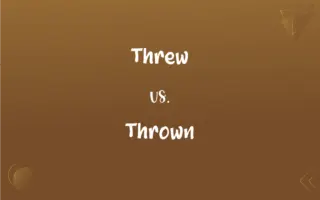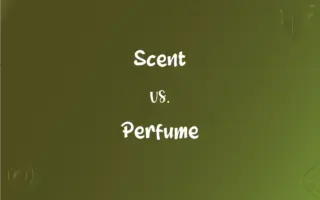Diamond vs. Pearl: What's the Difference?
Edited by Aimie Carlson || By Janet White || Published on December 10, 2023
Diamond is a hard, precious gemstone made of carbon; Pearl is a soft, lustrous gem produced by mollusks.

Key Differences
Diamonds are formed deep within the Earth's mantle under extreme heat and pressure, making them the hardest known natural material. They are composed of carbon atoms arranged in a crystal lattice. Diamonds are renowned for their brilliance and are often used in jewelry. Pearls, in contrast, are organic gems produced within the soft tissue of living mollusks, like oysters and mussels. Pearls form as a response to an irritant inside the mollusk's shell and are composed primarily of calcium carbonate.
Diamonds are valued for their clarity, cut, color, and carat weight, factors that determine their quality and price. They are often associated with engagement rings and fine jewelry. The process of cutting and polishing a diamond is intricate, enhancing its ability to reflect light and sparkle. Pearls are valued for their luster, size, shape, and color. Unlike diamonds, pearls do not require cutting or polishing and are appreciated for their natural beauty. Pearls come in various colors and shapes, with perfectly round and lustrous pearls being the most prized.
The creation of a diamond can take billions of years, and their durability and hardness make them ideal for industrial applications, such as in cutting and grinding tools. Pearls are formed over a few years and are much softer, making them unsuitable for industrial use but highly valued in jewelry for their unique luster and beauty.
In terms of care, diamonds require minimal maintenance due to their hardness and are resistant to scratching. They can be cleaned with simple methods at home. Pearls, however, are more delicate, requiring careful handling to avoid damage from chemicals, heat, and physical impact. Pearls are best cleaned with a soft, damp cloth and should be stored separately to avoid scratches.
Diamonds and pearls are both precious gemstones used in jewelry but differ significantly in their origin, composition, properties, and use. Diamonds are hard and sparkling, formed from carbon under Earth's surface, while pearls are soft, lustrous gems formed organically within mollusks.
ADVERTISEMENT
Comparison Chart
Composition
Carbon atoms in a crystal structure.
Layers of calcium carbonate (nacre) in a mollusk.
Formation
Under high pressure and temperature in the Earth.
Inside mollusks as a response to an irritant.
Hardness
The hardest natural material.
Much softer, can be scratched easily.
Use in Jewelry
Cut and polished for brilliance.
Used in their natural state, valued for luster.
Industrial Use
Widely used in cutting and grinding tools.
No industrial use, purely ornamental.
ADVERTISEMENT
Diamond and Pearl Definitions
Diamond
Carbon Crystal.
Diamonds are formed from carbon under extreme conditions.
Pearl
Iridescent Luster.
The pearl's luster gives it a soft, glowing appearance.
Diamond
Precious Gemstone.
A diamond ring is often chosen for engagements.
Pearl
Used in Fine Jewelry.
Pearl necklaces are a classic and elegant jewelry choice.
Diamond
Brilliant Sparkle.
The diamond's cut enhances its natural sparkle.
Pearl
Organic Gem.
Pearls are unique gems formed inside oysters.
Diamond
Valuable for Jewelry.
Diamonds are prized for their clarity and carat weight.
Pearl
Cultured or Natural.
Pearls can be naturally occurring or cultured by humans.
Diamond
Hardest Natural Substance.
Diamonds are used in cutting tools due to their hardness.
Pearl
Variety of Colors.
Pearls come in various colors, from white to black.
Diamond
An extremely hard, highly refractive crystalline form of carbon that is usually colorless and is used as a gemstone and in abrasives, cutting tools, and other applications.
Pearl
A smooth, lustrous, variously colored mass, chiefly of calcium carbonate, formed around a grain of sand or other foreign matter inside the shell of certain bivalve mollusks and valued as a gem.
Diamond
A piece of jewelry containing such a gemstone.
Pearl
A bead resembling one of these masses.
FAQs
How are diamonds formed?
Diamonds are formed deep within the Earth under extreme pressure and heat, and are brought to the surface through volcanic eruptions.
How are pearls formed?
Pearls are formed when an irritant, like a grain of sand, gets trapped in an oyster's shell, and the oyster secretes layers of nacre around it.
Are diamonds the hardest natural substance?
Yes, diamonds are the hardest known natural material.
Are there synthetic pearls?
Yes, synthetic or cultured pearls are created by artificially inserting an irritant into a mollusk.
What is a diamond?
A diamond is a precious gemstone made of crystallized carbon, known for its hardness and brilliance.
What is a pearl?
A pearl is a smooth, round gem formed inside the shell of an oyster or a mussel.
What factors affect a pearl's value?
A pearl's value depends on its size, shape, color, surface quality, and luster.
Are pearls considered rare?
Natural pearls are very rare, but cultured pearls are more common and affordable.
What are synthetic diamonds?
Synthetic diamonds are man-made diamonds created in a laboratory, having the same physical properties as natural diamonds.
Can diamonds come in different colors?
Yes, besides traditional clear diamonds, there are colored diamonds known as "fancy diamonds."
Is pearl harvesting sustainable?
Cultured pearl farming can be sustainable, but it depends on the practices of the pearl farm and the health of the water ecosystem.
Is diamond mining harmful to the environment?
Yes, diamond mining can be environmentally damaging and is often associated with ethical concerns.
What is the most common use of diamonds?
Diamonds are most commonly used in jewelry, particularly in engagement rings.
Can pearls come in different colors?
Yes, pearls can be white, cream, pink, silver, or even black, depending on the type of mollusk and water conditions.
What determines a diamond's value?
A diamond's value is determined by the four Cs: Cut, Color, Clarity, and Carat weight.
Can diamonds be used for industrial purposes?
Yes, due to their hardness, diamonds are used in cutting, grinding, and drilling tools.
What is the largest diamond ever found?
The largest diamond ever discovered is the Cullinan diamond, which originally weighed 3,106 carats.
What is nacre in pearls?
Nacre, also known as mother of pearl, is the iridescent substance that forms the outer coating of pearls.
Are all diamonds and pearls valuable?
The value of diamonds and pearls varies widely based on quality, size, and rarity.
What are the main types of pearls?
The main types of pearls are freshwater, Akoya, Tahitian, and South Sea pearls.
About Author
Written by
Janet WhiteJanet White has been an esteemed writer and blogger for Difference Wiki. Holding a Master's degree in Science and Medical Journalism from the prestigious Boston University, she has consistently demonstrated her expertise and passion for her field. When she's not immersed in her work, Janet relishes her time exercising, delving into a good book, and cherishing moments with friends and family.
Edited by
Aimie CarlsonAimie Carlson, holding a master's degree in English literature, is a fervent English language enthusiast. She lends her writing talents to Difference Wiki, a prominent website that specializes in comparisons, offering readers insightful analyses that both captivate and inform.






































































